Astrochemistry of star forming regions
The EMoCA and ReMoCA surveys
The CALYPSO survey
Star formation in Chamaeleon
Astrochemistry of star forming regions
Molecules allow us to probe the physical conditions of the interstellar medium, such as its temperature, density, and kinematics, or the radiation field and cosmic rays that impinge on it. They also reveal the chemical composition of astronomical environments, in particular star forming regions. This chemical composition is a powerful tool to probe the history of these regions and reveal their evolutionary stage. More than 300 distinct molecules have been detected in the interstellar medium so far with a detection rate of nearly five new molecules per year since the late 1960s, thanks to the advent of radio astronomy and the continuous improvements made in terms of sensitivity and spectral coverage since then.
Among the interstellar molecules detected in star forming regions, the most complex ones are all organic and are of special interest to us because their study can help us understand the interstellar origin of the rich inventory of molecules that has been revealed in meteorites fallen on Earth and, more recently, in comets that were the targets of space missions such as Stardust and Rosetta. Our group has used several mm/submm observational facilities such as the IRAM 30m telescope and the Atacama Large Millimeter/submillimeter Array (ALMA) to search for complex organic molecules in star forming regions and study the chemical composition of progenitors of high mass stars on the basis of spectral line surveys. Highlights have been the first detection of several complex organic molecules:
|
 |
|
|
 |
|
|
 |
|
|
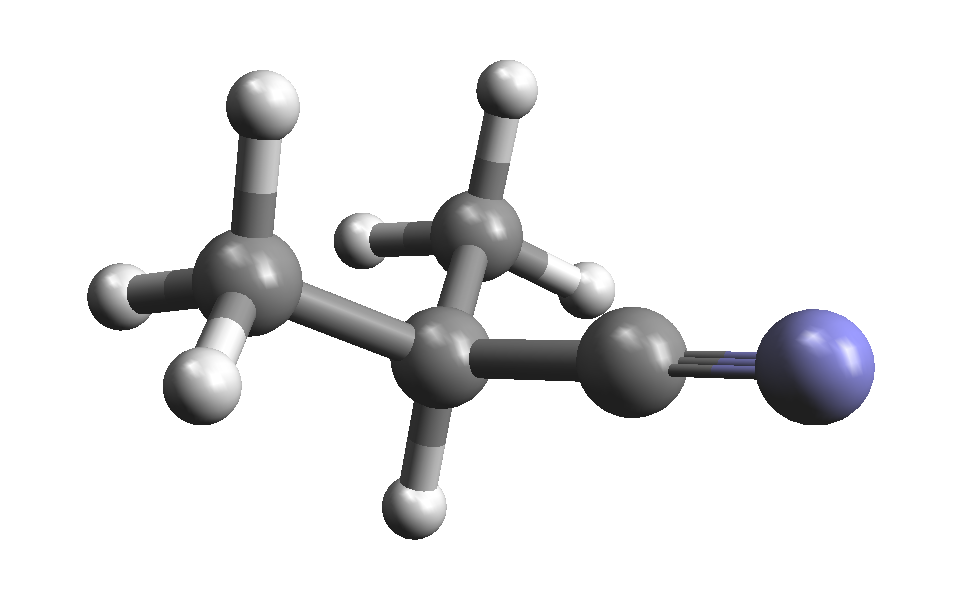 |
|
|
 |
|
|
 |
|
|
 |
Beyond simply extending the inventory of interstellar molecules, these detections allow us to test the predictions of chemical models in close collaboration with theoreticians, and in turn learn about the chemical processes that lead to chemical complexity in the interstellar medium.
My colleagues Jes Jørgensen, Rob Garrod, and I wrote a review on astrochemistry during the formation of stars, with a focus on complex organic molecules. This review revealed in particular that the chemical composition of different star-forming environments (high-mass versus low-mass, Galactic Center versus Galactic disk) shows a remarkable similarity.
The EMoCA and ReMoCA surveys
The giant molecular cloud complex Sagittarius B2 (Sgr B2) is one of the most active star-forming regions in our Galaxy. It is located close to the center of the Milky Way. It hosts several protoclusters that contain dozens of compact ionized (HII) regions which are signposts of young high-mass stars. Sgr B2 was one of the main sources targeted by radio telescopes when molecular radio astronomy took off in the late 1960s. It turned out to be one of the best sources to study the molecular complexity of the interstellar medium: many complex organic molecules known in the interstellar medium to date were first detected in this source.
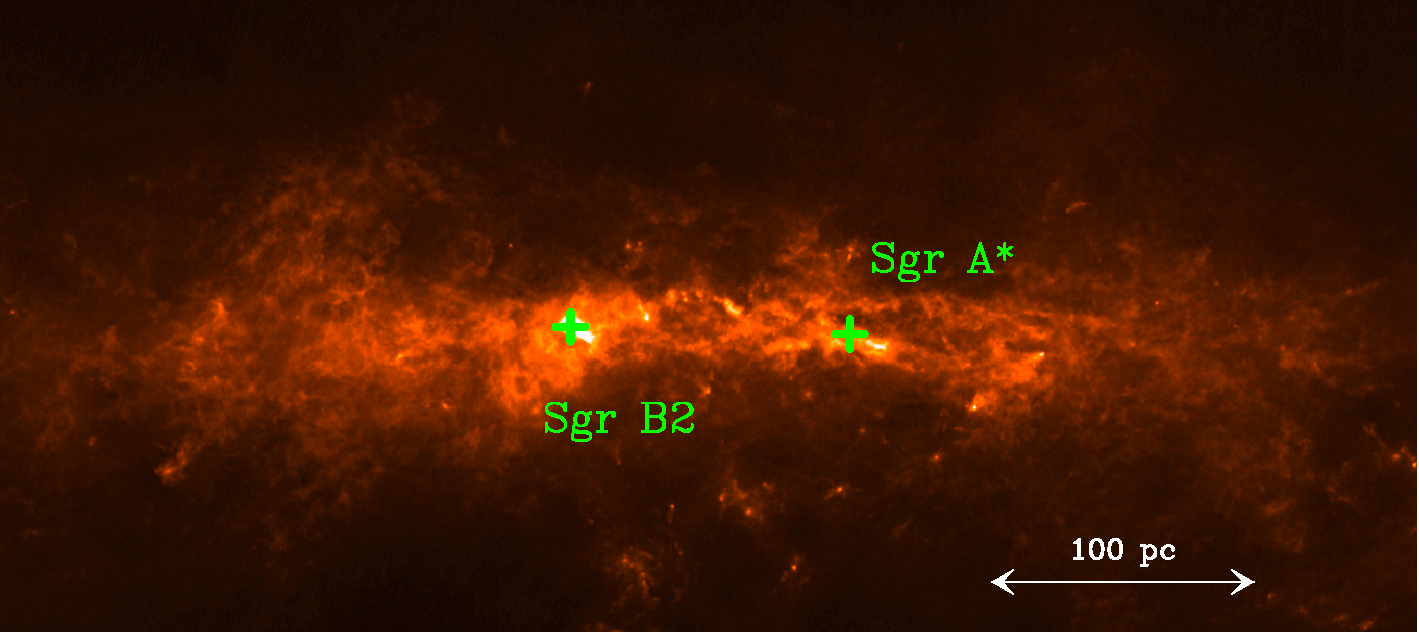
The two main protoclusters of Sgr B2, Sgr B2(N) and Sgr B2(M), contain several hot molecular cores which are the hot (>100 K) inner regions of the envelopes of high-mass (proto)stars. In these hot environments, organic molecules formed in the ice mantles of dust grains during earlier, colder phases sublimate. Once in the gas phase, their rotational emission can be detected with radio telescopes, which gives us access to the chemical composition of these environments.
EMoCA and ReMoCA
Our initial exploration of the molecular content of Sgr B2(N) and Sgr B2(M) with the IRAM 30 m telescope led to the first interstellar detection of several complex organic molecules. We then initiated a long term project with ALMA to explore the chemical composition of Sgr B2(N) at high angular resolution in the 3 mm atmospheric window. This survey is called EMoCA, which stands for Exploring Molecular Complexity with ALMA. Additional sensitive observations with ALMA at even higher angular resolution were performed a few years later, and we named this second survey ReMoCA. The analysis of both surveys is still ongoing, but it has already led to the first interstellar detection of several complex organic molecules.

New hot cores
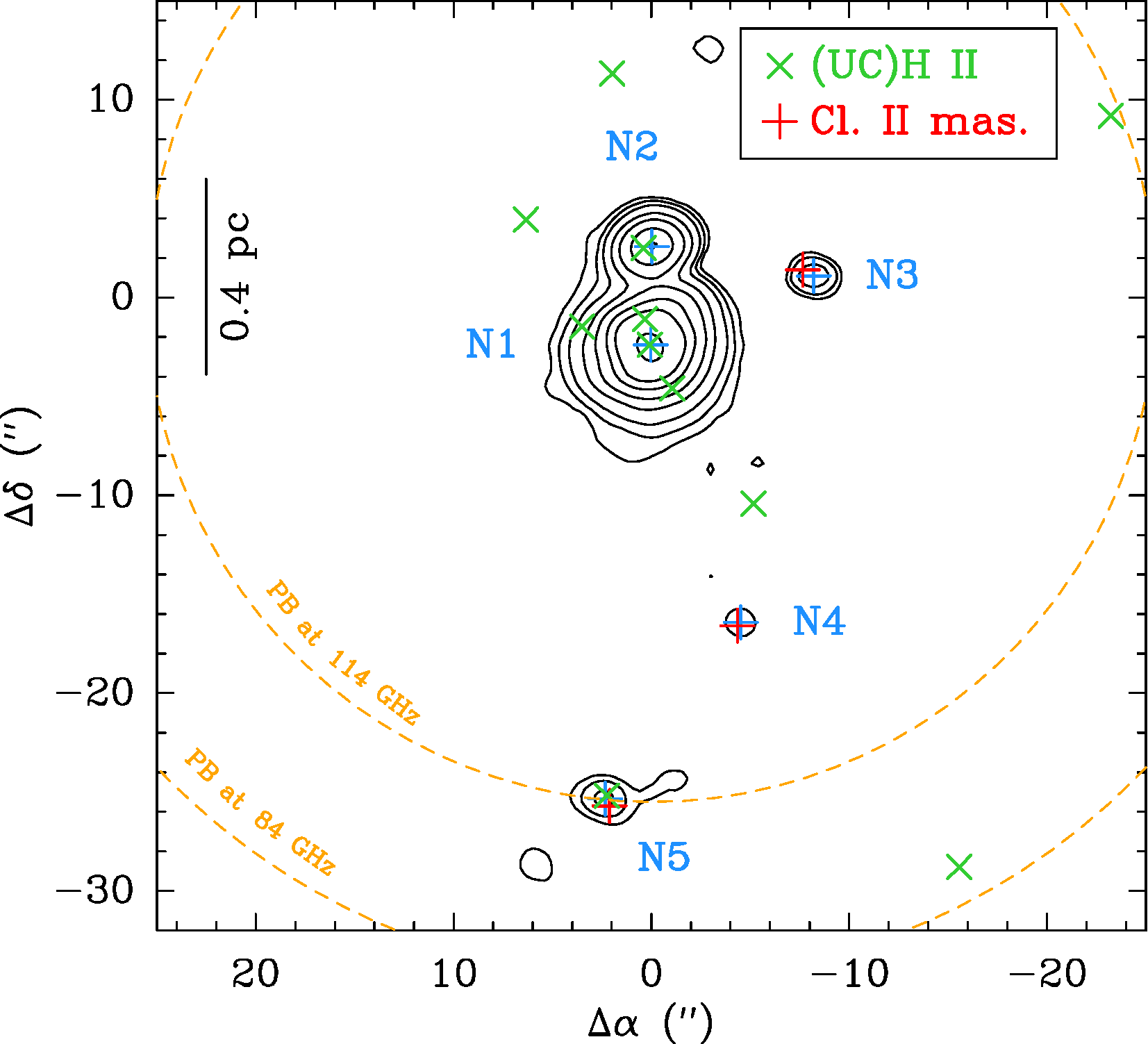 The EMoCA survey has revealed three new hot cores in Sgr B2(N) in addition to the two hot cores that were already known before. A detailed analysis of their chemical composition led by Mélisse Bonfand in the course of her doctoral thesis, coupled with numerical simulations that she performed with the astrochemical code MAGICKAL of our collaborator R. Garrod, suggests in particular a cosmic-ray ionization rate enhanced by a factor 50 compared to the solar neighborhood value. In the frame of the model, we could also conclude that the minimum temperature reached during the colder, prestellar phase could not be higher than 25 K, and that a minimum temperature as high as 15 K can still lead to an efficient formation of complex organic molecules on dust grains.
The EMoCA survey has revealed three new hot cores in Sgr B2(N) in addition to the two hot cores that were already known before. A detailed analysis of their chemical composition led by Mélisse Bonfand in the course of her doctoral thesis, coupled with numerical simulations that she performed with the astrochemical code MAGICKAL of our collaborator R. Garrod, suggests in particular a cosmic-ray ionization rate enhanced by a factor 50 compared to the solar neighborhood value. In the frame of the model, we could also conclude that the minimum temperature reached during the colder, prestellar phase could not be higher than 25 K, and that a minimum temperature as high as 15 K can still lead to an efficient formation of complex organic molecules on dust grains.
Translucent clouds
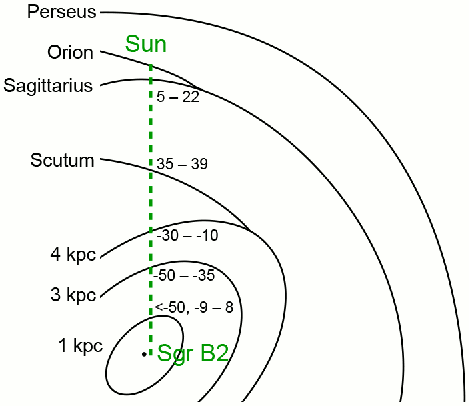 Molecular clouds distributed along the line of sight are detected in absorption against the strong continuum emission of Sgr B2 in the EMoCA survey. The analysis of these absorption lines, led by Vivien Thiel in the course of her doctoral thesis, indicates that most of these intervening clouds are translucent rather than diffuse. We could also conclude that CCH and CH are good probes of H2 in both diffuse and translucent clouds while HCO+ and c-C3H2 depart from the correlations with H2 found in diffuse clouds in the past. The EMoCA survey also allowed the detection of complex organic molecules in translucent clouds. These findings, compared to detections made in a galaxy at a redshift of 0.89, suggest that the processes leading to chemical complexity in the diffuse and translucent molecular interstellar medium have remained similar since the Universe was half of its age.
Molecular clouds distributed along the line of sight are detected in absorption against the strong continuum emission of Sgr B2 in the EMoCA survey. The analysis of these absorption lines, led by Vivien Thiel in the course of her doctoral thesis, indicates that most of these intervening clouds are translucent rather than diffuse. We could also conclude that CCH and CH are good probes of H2 in both diffuse and translucent clouds while HCO+ and c-C3H2 depart from the correlations with H2 found in diffuse clouds in the past. The EMoCA survey also allowed the detection of complex organic molecules in translucent clouds. These findings, compared to detections made in a galaxy at a redshift of 0.89, suggest that the processes leading to chemical complexity in the diffuse and translucent molecular interstellar medium have remained similar since the Universe was half of its age.
Desorption of complex organic molecules
The high angular resolution of the ReMoCA survey allowed Laura Busch to derive the temperature and abundance profiles of a dozen of organic molecules toward the main hot core of Sgr B2(N) in the frame of her doctoral thesis. This in-depth analysis resolved for the first time the desorption behaviour of complex organic molecules in a hot core and led to the conclusion that complex organic molecules co-desorb with water at a temperature of about 100 K. Furthermore, non-zero abundances of these molecules below 100 K suggest that another desorption mechanism occurs at lower temperatures, either non-thermal desorption or partial thermal desorption related to the lower binding energies of these molecules in the outer, water-poor ice layers of dust grains.
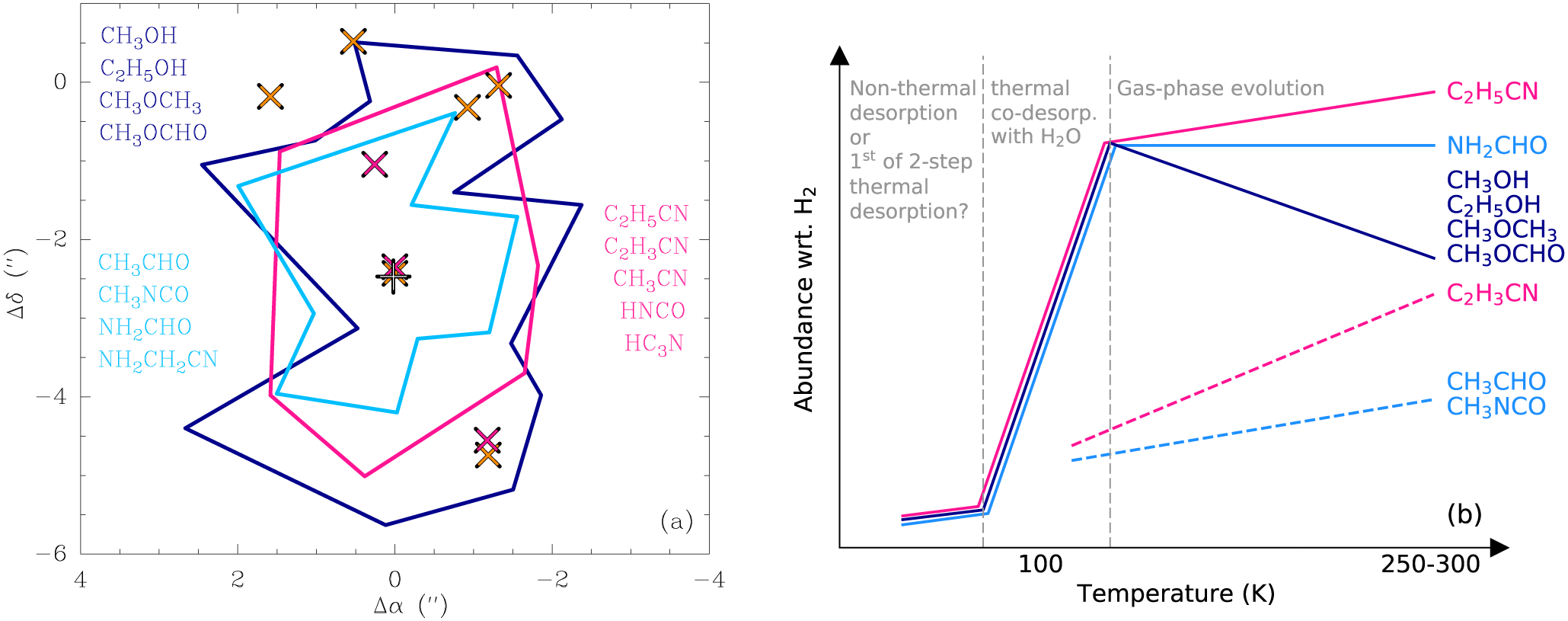
Impact of Sgr B2(N1)'s outflow on complex organic molecules
The main hot core of Sgr B2(N) drives a powerful bipolar outflow. In the frame of her doctoral thesis, Laura Busch identified rotational emission of complex organic molecules at blueshifted and redshifted frequencies at positions associated with the outflow, suggesting that they have been impacted by shocks. The detailed analysis of their column densities revealed that oxygen-bearing molecules behave differently from nitrogen-bearing ones: while the abundance of oxygen-bearing molecules drops in the post-shock gas, the abundance of most nitrogen-bearing ones remains similar in the outflow and hot core components. The abundance of cyanopolyynes even increases in the outflow.
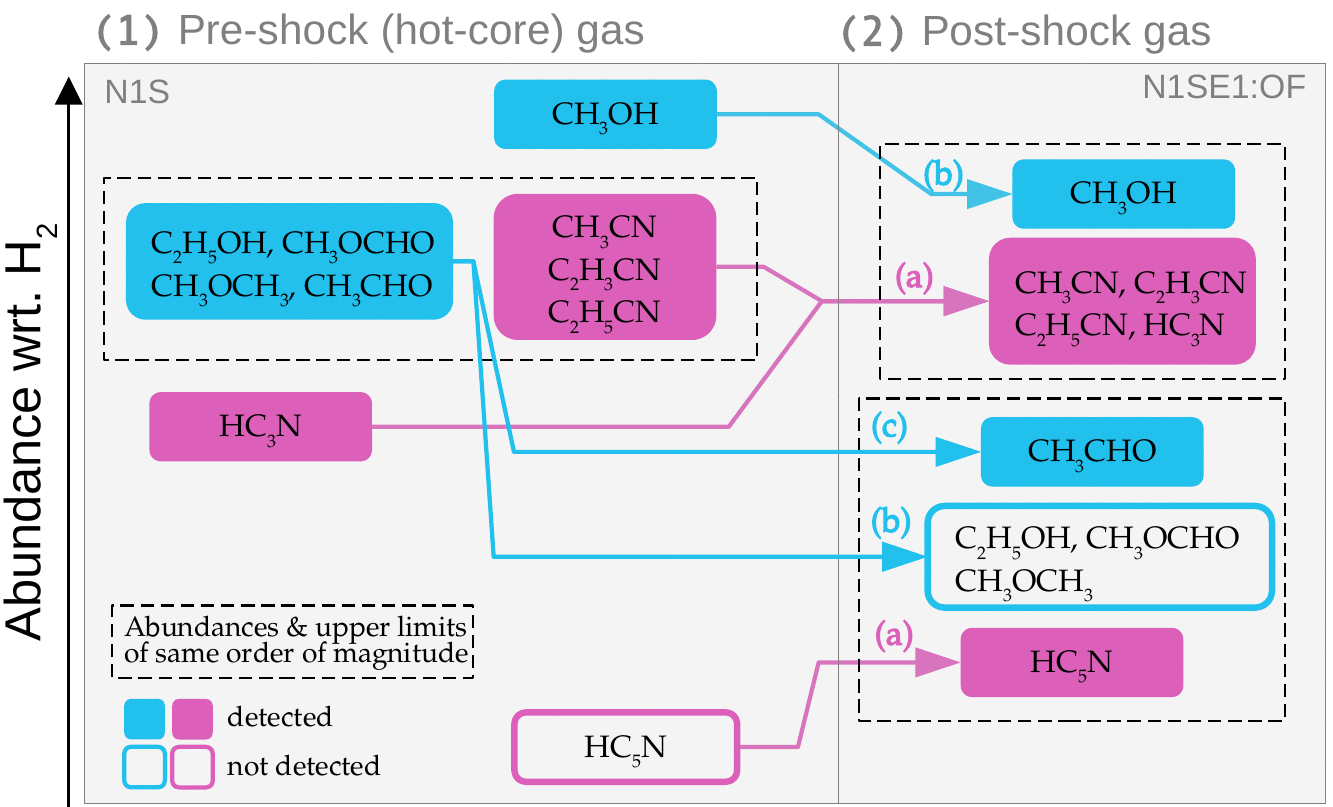
These results suggest a lack of efficient formation routes of oxygen-bearing complex organic molecules in the gas phase while such routes must exist for nitrogen-bearing ones. This brings a new perspective on the chemical segregation of oxygen- and nitrogen-bearing molecules that was reported earlier in other star forming regions.
The CALYPSO survey
Class 0 protostars are key objects along the evolutionary path that leads to the formation of Sun-like stars in molecular clouds. They represent the earliest stage of the main accretion phase when a stellar embryo has just formed but most of the mass is still stored in the collapsing protostellar envelope. The gravitational collapse of their envelopes initiates the formation of circumstellar disks which then turn into protoplanetary disks and set the initial conditions for planet formation. Several issues remain in our understanding of the formation of Sun-like stars, in particular how protostars get rid of most of the angular momentum initially stored in their envelopes. This is the so-called angular momentum problem of star formation.
The CALYPSO survey conducted at millimeter wavelengths with the IRAM Plateau de Bure interferometer, now called NOEMA, was set up to tackle this angular momentum problem. CALYPSO stands for Continuum And Lines in Young ProtoStellar Objects. It is a continuum and spectral-line survey of a sample of 16 Class 0 protostars located in nearby star forming regions. As part of the CALYPSO team, we contributed to the analysis of the spectral line emission detected with the interferometer. We investigated the chemical composition of the inner regions of the CALYPSO sources.
The CALYPSO survey has revealed the presence of complex organic molecules in half of the sample. We found in particular a strong chemical differentiation in multiple systems, with five systems having one component associated with emission from complex organic molecules but the other component devoid of such emission. These findings raise the question of whether all low-mass protostars go through a phase showing emission of complex organic molecules.
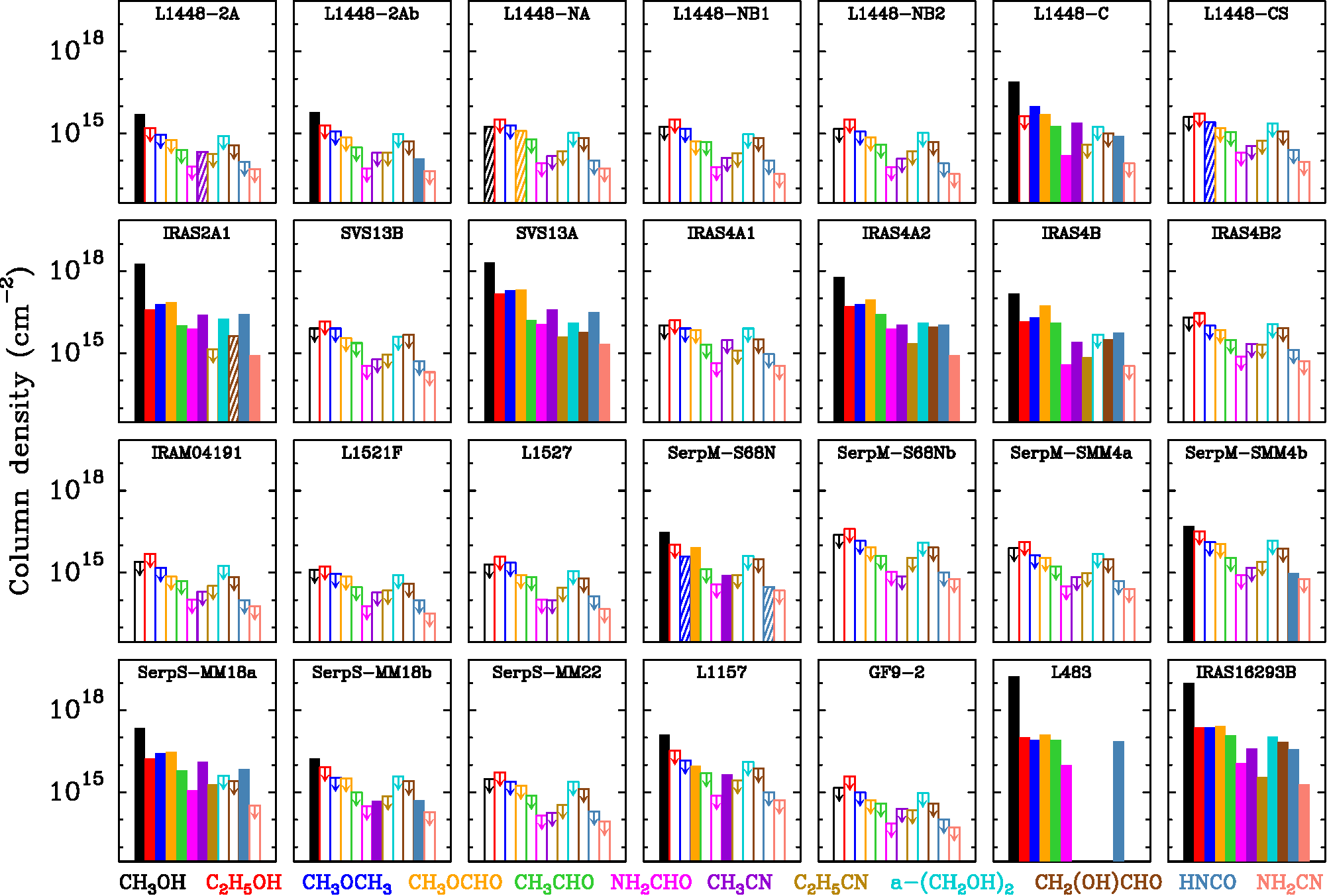
Several scenarios involving either the heating of the envelope by the central object, an accretion shock at the boundary between the disk and the collapsing envelope, or processes related to the outflow may explain the origin of this molecular emission in the CALYPSO sources, but a unified scenario still has to be found. We classified the CALYPSO sources associated with emission of complex organic molecules into three groups according to their chemical composition. The meaning of these three groups is still a mystery.
Star formation in Chamaeleon
The Chamaeleon molecular cloud complex is a nearby star forming region. It mainly consists of three molecular clouds, called Chamaeleon I, II, and III. These clouds show different degrees of star formation activity, which makes the Chamaeleon cloud complex a prime target to study star formation in the neighborhood of our Sun. Because of its low declination of about -80°, this region can only be observed from observatories located in the Southern hemisphere. We used the APEX telescope situated in the north of Chile to probe star formation in Chamaeleon I and III. In particular we focused our attention on an interesting young stellar object called Cha-MMS1 that we further observed with ALMA.
Chamaeleon I and III
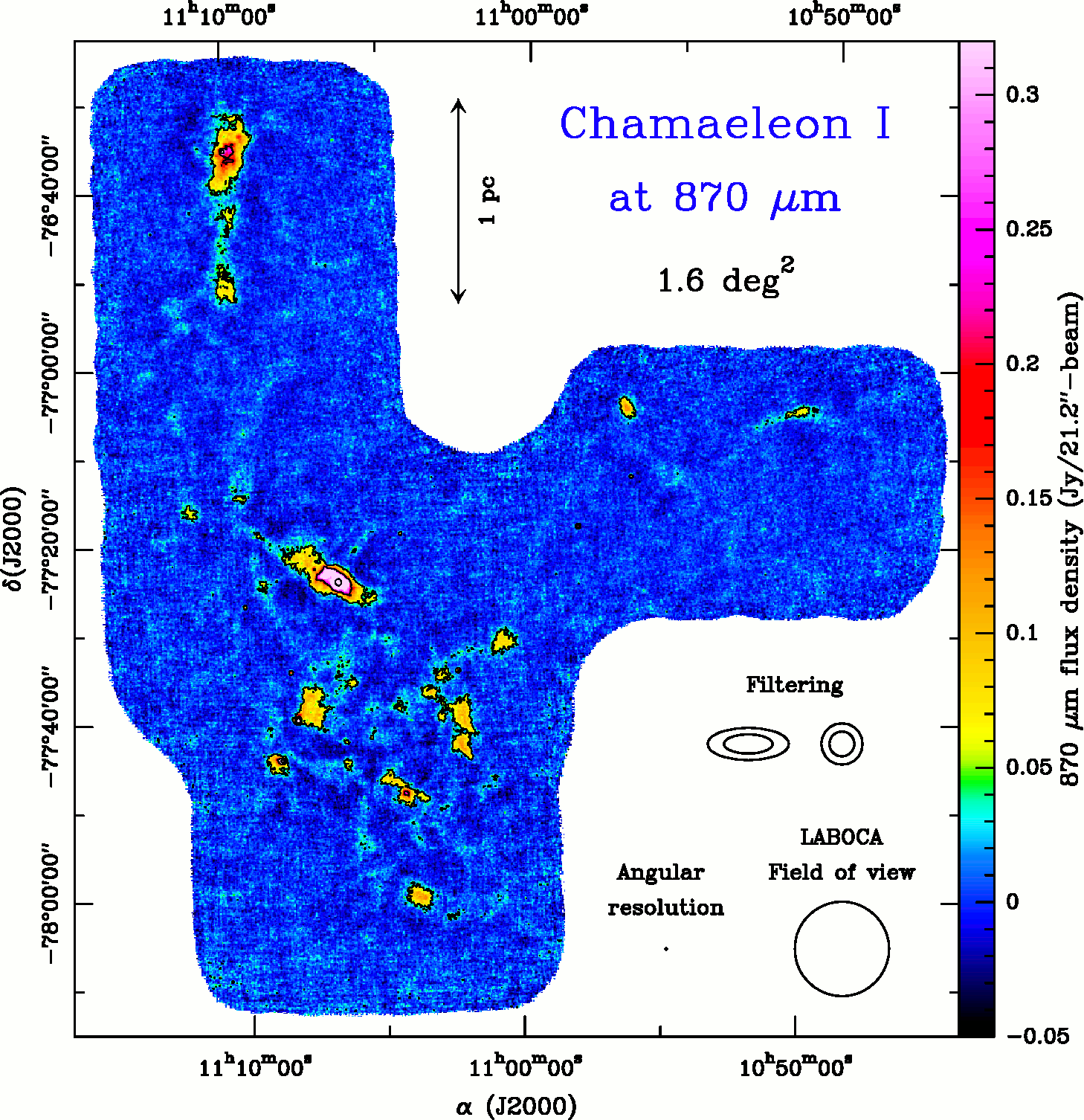 We used the multi-channel bolometer array LABOCA at the APEX telescope to map the dust continuum emission of Chamaeleon I and III at a wavelength of 870 μm. Dozens of dense cores were detected in each cloud. A detailed analysis of this population of dense cores led us to conclude that we may be witnessing the end of the star formation process in Chamaeleon I. By contrast, we came to the conclusion that Chamaeleon III may be on the verge of forming stars, which makes this cloud an excellent target to study the onset of star formation.
We used the multi-channel bolometer array LABOCA at the APEX telescope to map the dust continuum emission of Chamaeleon I and III at a wavelength of 870 μm. Dozens of dense cores were detected in each cloud. A detailed analysis of this population of dense cores led us to conclude that we may be witnessing the end of the star formation process in Chamaeleon I. By contrast, we came to the conclusion that Chamaeleon III may be on the verge of forming stars, which makes this cloud an excellent target to study the onset of star formation.
Our subsequent spectral line observations of the dense cores of Chamaeleon I and III with the APEX and Mopra telescopes revealed that the dense cores in Chamaeleon III are less chemically evolved than those in the central part of Chamaeleon I. We also detected the signature of contraction motions in starless cores of Chamaeleon III. These findings obtained by Anastasia Tsitali in the course of her doctoral thesis confirmed that Chamaeleon III is younger than Chamaeleon I.
Cha-MMS1
Cha-MMS1 is a young stellar object embedded in a prominent dense core in Chamaeleon I. Our early study of its molecular line emission probed with the APEX telescope and its association with an infrared source detected with the Spitzer Space telescope suggested that it could be a so-called first hydrostatic core. First hydrostatic cores correspond to the short phase theoretically expected between the prestellar and protostellar phases, when an hydrostatic object still made of molecular hydrogen has formed at the heart of a gravitationally collapsing dense core. Because of their short lifetime, first hydrostatic cores are rare and difficult to find.
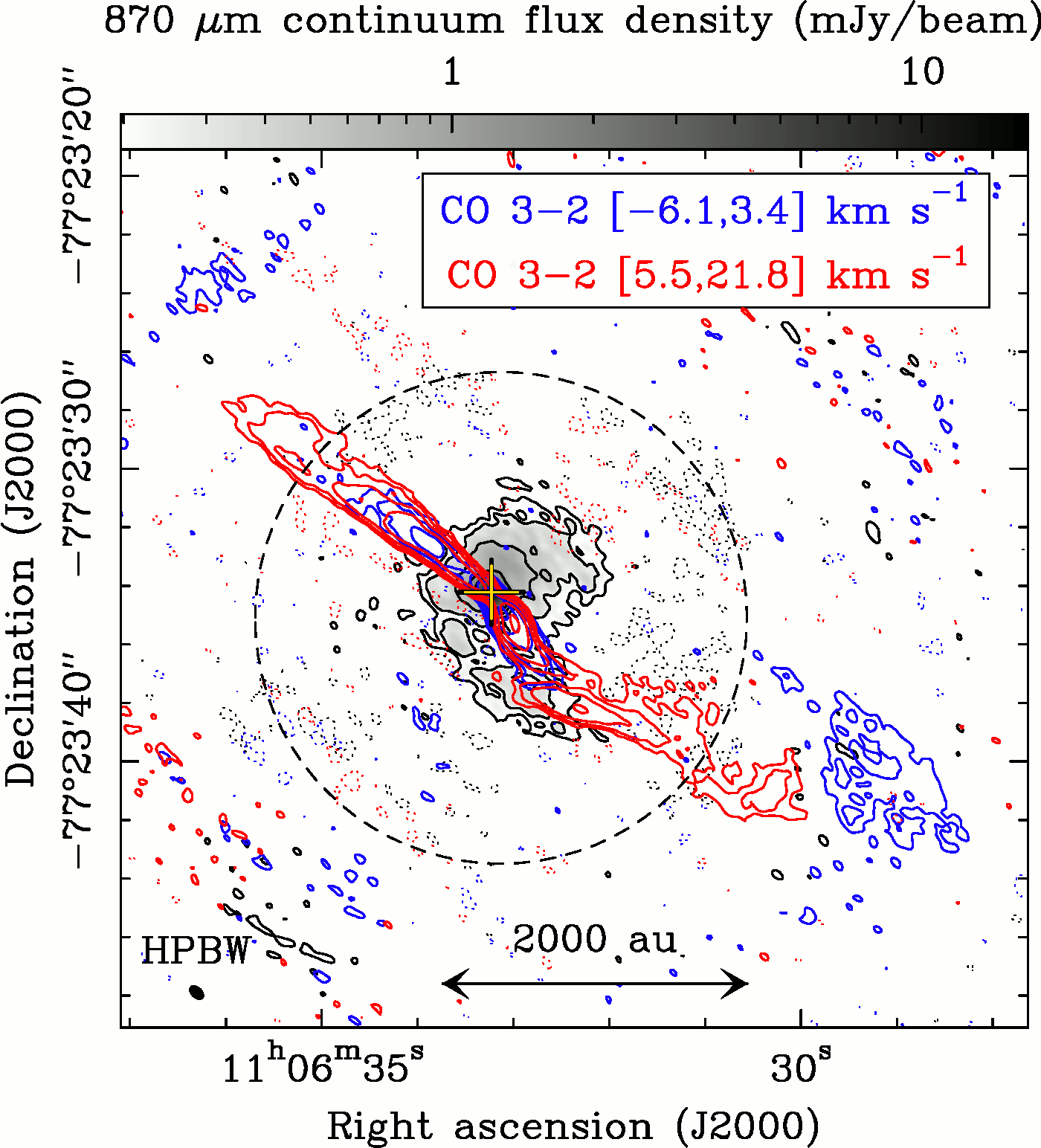 Our subsequent study of the luminosity of Cha-MMS1 and the kinematics of its envelope probed with the APEX telescope, led by A. Tsitali, showed that Cha-MMS1 could be a first hydrostatic core or a slightly more evolved, young protostar. Further progress to decipher its evolutionary stage could only be made with observations at higher angular resolution. The high resolving power and sensitivity of ALMA allowed us to detect for the first time a collimated outflow driven by Cha-MMS1. The outflow turned out to be more extended than what was expected for a first hydrostatic core. The conclusion of this interferometric study, led by Laura Busch in the course of a research internship, is that Cha-MMS1 is a young protostar that has already gone through the first-hydrostatic-core phase but has not yet brought its outflow to full power.
Our subsequent study of the luminosity of Cha-MMS1 and the kinematics of its envelope probed with the APEX telescope, led by A. Tsitali, showed that Cha-MMS1 could be a first hydrostatic core or a slightly more evolved, young protostar. Further progress to decipher its evolutionary stage could only be made with observations at higher angular resolution. The high resolving power and sensitivity of ALMA allowed us to detect for the first time a collimated outflow driven by Cha-MMS1. The outflow turned out to be more extended than what was expected for a first hydrostatic core. The conclusion of this interferometric study, led by Laura Busch in the course of a research internship, is that Cha-MMS1 is a young protostar that has already gone through the first-hydrostatic-core phase but has not yet brought its outflow to full power.
"A sanitizer in the galactic centre region"
(June 28, 2022)
"Interstellar molecules are branching out"
(September 25, 2014)
"Tracking down organic molecules"
(April 21, 2009)
"New organic molecule in space"
(March 26, 2008)
Welcome to my homepage!
 I am an astronomer at the Max-Planck-Institut für Radioastronomie in Bonn, Germany. I am a member of its Millimeter and Submillimeter Astronomy department. I was born in France, grew up in a Norman village, studied physics near Paris, and moved to Germany soon after completing my doctoral thesis in astrophysics.
I am an astronomer at the Max-Planck-Institut für Radioastronomie in Bonn, Germany. I am a member of its Millimeter and Submillimeter Astronomy department. I was born in France, grew up in a Norman village, studied physics near Paris, and moved to Germany soon after completing my doctoral thesis in astrophysics.
My main research interests are star formation and astrochemistry. I am particularly curious about the growth of molecular complexity in regions of our Galaxy where stars are being formed. I observe the spectral signatures of interstellar organic molecules using powerful radio telescopes such as the Atacama Large Millimeter/submillimeter Array (ALMA) or the NOrthern Extended Millimeter Array (NOEMA) of the Institut de Radioastronomie Millimétrique (IRAM).
I am also frequently in Chile to perform observations with the Atacama Pathfinder EXperiment (APEX).
In my free time, I love playing the clarinet.
Contact:
Max-Planck-Institut für Radioastronomie
Auf dem Hügel 69
53121 Bonn
Germany
phone: +49 228525376
email: belloche AT mpifr-bonn.mpg.de
